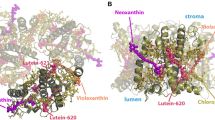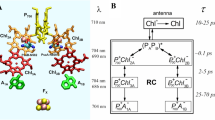Abstract
Accumulation of reduced pheophytin a (Pheo-D1) in photosystem II reaction center (PSII RC) under illumination at low redox potential is accompanied by changes in absorbance and circular dichroism spectra. The temperature dependences of these spectral changes have the potential to distinguish between changes caused by the excitonic interaction and temperature-dependent processes. We observed a conformational change in the PSII RC protein part and changes in the spatial positions of the PSII RC pigments of the active D1 branch upon reduction of Pheo-D1 only in the case of high temperature (298 K) dynamics. The resulting absorption difference spectra of PSII RC models equilibrated at temperatures of 77 K and 298 K were highly consistent with our previous experiments in which light-induced bleaching of the PSII RC absorbance spectrum was observable only at 298 K. These results support our previous hypothesis that Pheo-D1 does not interact excitonically with the other chlorins of the PSII RC, since the reduced form of Pheo-D1 causes absorption spectra bleaching only due to temperature-dependent processes.








Similar content being viewed by others
Notes
Multiple time steps of 1 fs for intramolecular and 2 fs for intermolecular forces was found the most appropriate. A cutoff of 0.8 nm was used for Lennard-Jones and electrostatic interactions. To treat long-range electrostatic interactions outside the cutoff region, the particle mesh Ewald (PME) method [53] with a grid spacing < 0.1nm, 4th order B-splines and a tolerance of 10−4 for the direct space sum were used. The temperature was adjusted by Berendsen thermostat [54] based on the time-averaged temperature.
References
Rhee KH, Morris EP, Barber J, Kuhlbrandt W (1998) Three-dimensional structure of the plant photosystem II reaction centre at 8 A resolution. Nature 396(6708):283–286
Loll B, Kern J, Saenger W, Zouni A, Biesiadka J (2005) Towards complete cofactor arrangement in the 3.0A resolution structure of photosystem II. Nature 438(7070):1040–1044
Biesiadka J, Loll B, Kern J, Irrgang KD, Zouni A (2004) Crystal structure of cyanobacterial photosystem II at 3.2 angstrom resolution: a closer look at the Mn-cluster. Phys Chem Chem Phys 6(20):4733–4736
Ferreira KN, Iverson TM, Maghlaoui K, Barber J, Iwata S (2004) Architecture of the photosynthetic oxygen-evolving center. Science 303(5665):1831–1838
Kamiya N, Shen JR (2003) Crystal structure of oxygen-evolving photosystem II from Thermosynechococcus vulcanus at 3.7-A resolution. Proc Natl Acad Sci USA 100(1):98–103
Zouni A, Witt H-T, Kern J, Fromme P, Krauss N, Saenger W, Orth P (2001) Crystal structure of photosystem II from Synechococcus elongates at 3.8 Å resolution. Nature 409:739–743
Durrant JR, Klug DR, Kwa SL, van Grondelle R, Porter G, Dekker JP (1995) A multimer model for P680, the primary electron donor of Photosystem II. Proc Natl Acad Sci USA 92(11):4798–4802
Vasil’ev S, Bruce D (2006) A protein dynamics study of Photosystem II: the effects of protein conformation on reaction center function. Biophys J 90(9):3062–3073
Palencar P, Vacha F, Kuty M (2005) Force field development on pigments of photosystem 2 reaction centre. Photosynthetica 43(3):417–420
Raszewski G, Saenger W, Renger T (2005) Theory of optical spectra of photosystem II reaction centers: location of the triplet state and the identity of the primary electron donor. Biophys J 88(2):986–998
Vacha F, Psencik J, Kuty M, Durchan M, Siffel P (2005) Evidence for localization of accumulated chlorophyll cation on the D1-accessory chlorophyll in the reaction centre of Photosystem II. Photosynth Res 84:297–302
Prokhorenko VI, Steensgaard DB, Holzwarth AR (2003) Exciton theory for supramolecular chlorosomal aggregates: 1. Aggregate size dependence of the linear spectra. Biophys J 85(5):3173–3186
Chang JC (1977) Monopole effects on electronic excitation interactions between large molecules. I. Application to energy transfer in chlorophylls. J Chem Phys 67(9):3901–3909
Barter LMC, Durrant JR, Klug DR (2003) A quantitative structure-function relationship for the Photosystern II reaction center: supermolecular behavior in natural photosynthesis. Proc Natl Acad Sci USA 100:946–951
Psencik J, Ma YZ, Arellano JB, Hala J, Gillbro T (2003) Excitation energy transfer dynamics and excited-state structure in chlorosomes of chlorobium phaeobacteroides. Biophys J 84(2):1161–1179
Jankowiak R, Hayes JM, Small GJ (2002) An excitonic pentamer model for the core Q(y) states of the isolated photosystem II reaction center. J Phys Chem B 106(34):8803–8814
Renger T, Marcus RA (2002) Photophysical properties of PS-2 reaction centers and a discrepancy in exciton relaxation times. J Phys Chem B 106(7):1809–1819
Dekker JP, Van Grondelle R (2000) Primary charge separation in Photosystem II. Photosynth Res 63(3):195–208
Pearlstein RM (1991) Theoretical interpretation of antenna spectra. In: Scheer H (ed) Chlorophylls. CRC, Bocca Raton, FL, pp 1047–1078
Vacha F, Durchan M, Siffel P (2002) Excitonic interactions in the reaction centre of Photosystem II studied by using circular dichroism. Biochim Biophys Acta 1554:147–152
Konermann L, Gatzen G, Holzwarth AR (1997) Primaryrocesses and structure of the photosystem II reaction center. 5. Modeling of the fluorescence kinetics of the D1-D2-cyt-b559 complex at 77 K. J Phys Chem B 101:2933–2944
Krieger E, Darden T, Nabuurs SB, Finkelstein A, Vriend G (2004) Making optimal use of empirical energy functions: force-field parameterization in crystal space. Proteins 57(4):678–683
Yasara Biosciences, available via http://www.yasara.org/index.html
ModLoop server, available via http://alto.compbio.ucsf.edu/modloop/modloop.html
Cornell WD, Cieplak P, Bayly CI, Gould IR, Merz KM, Ferguson DM, Spellmeyer DC, Fox T, Caldwell JW, Kollman PA (1995) A 2nd generation force-field for the simulation of proteins, nucleic acids, and organic-molecules. J Am Chem Soc 117(19):5179–5197
Wang JM, Cieplak P, Kollman PA (2000) How well does a restrained electrostatic potential (RESP) model perform in calculating conformational energies of organic and biological molecules? J Comp Chem 21(12):1049–1074
MacKerell AD, Bashford D, Bellott M, Dunbrack RL, Evanseck JD, Field MJ, Fischer S, Gao J, Guo H, Ha S, Joseph-McCarthy D, Kuchnir L, Kuczera K, Lau FTK, Mattos C, Michnick S, Ngo T, Nguyen DT, Prodhom B, Reiher WE, Roux B, Schlenkrich M, Smith JC, Stote R, Straub J, Watanabe M, Wiorkiewicz-Kuczera J, Yin D, Karplus M (1998) All-atom empirical potential for molecular modeling and dynamics studies of proteins. J Phys Chem B (102):3586–3616
vanGunsteren WF, Daura X, Mark AE (1998) GROMOS force field. In: Encyclopaedia of Computational Chemistry 2. CRC, Boca Raton, pp 1211–1216
Ceccarelli M, Procacci P, Marchi M (2003) An ab initio force field for the cofactors of bacterial photosynthesis. J Comput Chem 24(2):129–142
Roothaan CCJ (1951) New developments in molecular orbital theory. Rev Mod Phys 23(2):69–89
Bayly CI, Cieplak P, Cornell WD, Kollman PA (1993) A well-behaved electrostatic potential based method using charge restraints for deriving atomic charges: the RESP model. J Phys Chem 97(40):10269–10280
Matyus E, Monticelli L, Kover KE, Xu Z, Blasko K, Fidy J, Tieleman DP (2006) Structural investigation of syringomycin-E using molecular dynamics simulation and NMR. Eur Biophys J 35(6):459–467
Stockner T, Ash WL, MacCallum JL, Tieleman DP (2004) Direct simulation of transmembrane helix association: role of asparagines. Biophys J 87(3):1650–1656
Aliste MP, MacCallum JL, Tieleman DP (2003) Molecular dynamics simulations of pentapeptides at interfaces: salt bridge and cation-pi interactions. Biochemistry 42(30):8976–8987
Tieleman DP, Berendsen HJ, Sansom MS (2001) Voltage-dependent insertion of alamethicin at phospholipid/water and octane/water interfaces. Biophys J 80(1):331–346
Tieleman DP (2006) Computer simulations of transport through membranes: passive diffusion, pores, channels and transporters. Clin Exp Pharmacol Physiol 33(10):893–903
MacCallum JL, Tieleman DP (2006) Computer simulation of the distribution of hexane in a lipid bilayer: spatially resolved free energy, entropy, and enthalpy profiles. J Am Chem Soc 128(1):125–130
Bayley PM (1973) The analysis of circular dichroism of biomolecules. Prog Biophys 27:1–76
Pullerits T (2000) Exciton states and relaxation in molecular aggregates: Numerical study of photosynthetic light harvesting. J Chin Chem Soc 47:773–784
Prokhorenko VI, Holzwarth AR (2000) Primary processes and structure of the photosystem II reaction center: a photon echo study. J Phys Chem B 104(48):11563–11578
Krawczyk S (1991) Electrochromism of chlorophyll-a monomer and special-pair dimer. Biochim Biophys Acta 1056(1):64–70
Sauer K, Cogdell RJ, Prince SM, Freer A, Isaacs NW, Scheer H (1996) Structure-based calculations of the optical spectra of the LH2 bacteriochlorophyll-protein complex from Rhodopseudomonas acidophila. Photochem Photobiol 64(3):564–576
Warshel A, Parson WW (1987) Spectroscopic properties of photosynthetic reaction centers. I. Theory. J Am Chem Soc 109:6143–6152
Parson WW, Warshel A (1987) Spectroscopic properties of photosynthetic reaction centers. II. Application of the theory to Rhodopseudomonas viridis. J Am Chem Soc 109:6152–6163
Petelenz P (2004) Charge-transfer interactions—their manifestations in electroabsorption spectra. J Lumin 110(4):325–331
Konermann L, Holzwarth AR (1996) Analysis of the absorption spectrum of photosystem II reaction centers: temperature dependence, pigment assignment, and inhomogeneous broadening. Biochemistry 35(3):829–842
MATLAB, http://www.mathworks.com/products/matlab/requirements.html
Frisch MJ, Trucks GW, Schlegel HB, Scuseria GE, Robb MA, Cheeseman JR, Zakrzewski VG, Montgomery JA, Stratmann RE, Burant JC, Dapprich S, Millam JM, Daniels AD, Kudin KN, Strain MC, Farkas O, Tomasi J, Barone V, Cossi M, Cammi R, Mennucci B, Pomelli C, Adamo C, Clifford S, Ochterski J, Petersson GA, Ayala PY, Cui Q, Morokuma K, Malick DK, Rabuck AD, Raghavachari K, Foresman JB, Cioslowski J, Ortiz JV, Stefanov BB, Liu G, Liashenko A, Piskorz P, Komaromi I, Gomperts R, Martin RL, Fox DJ, Keith T, Al-Laham MA, Peng CY, Nanayakkara A, Gonzalez C, Challacombe M, Gill PMW, Johnson BG, Chen W, Wong MW, Andres JL, Head-Gordon M, Replogle ES, Pople JA (1998) Gausian 98. Gaussian, Pittsburgh
Case DA, Pearlman DA, Caldwell JW, Cheatham TE 3rd, Wang J, Ross WS, Simmerling CL, Darden TA, Merz KM, Stanton RV, Cheng AL, Vincent JJ, Crowley M, Tsui V, Gohlke H, Radmer RJ, Duan Y, Pitera J, Massova I, Seibel GL, Singh UC, Weiner PK, Kollman PA (2002) AMBER 7, University of California, San Francisco
Vriend G (1990) WHAT IF: a molecular modeling and drug design program. J Mol Graph 8(1):52–56
Sayle RA, Milner-White EJ (1995) RASMOL: biomolecular graphics for all. Trends Biochem Sci 20(9):374
Lindahl E, Hess B, van der Spoel (2001) GROMACS: a package for molecular simulation and trajectory analysis. J Mol Model 7:306–317
Essmann U, Perera L, Berkowitz ML, Darden T, Lee H, Pedersen LG (1995) A smooth particle mesh Ewald method. J Chem Phys 103(19):8577–8593
Berendsen HJC, Postma JPM, vanGunsteren WF, DiNola A, Haak JR (1984) Molecular dynamics with coupling to an external bath. J Chem Phys 81(8):3684–3690
Acknowledgments
Support from the Institutional Research Concept of the Academy of Science of the Czech Republic (AVOZ60870520 and AV0Z50510513) and from the Ministry of Education of the Czech Republic (LC 06010 and MSM6007665808) and the Grant Agency of the Czech Republic (203/08/0114) is gratefully acknowledged.
Author information
Authors and Affiliations
Corresponding author
Electronic supplementary material
Below is the link to the electronic supplementary material
Supplementary Fig. 1
Conformational analysis of Neutral-MD (solid lines polynomically fitting raw data represented by squares) and Pheo–MD simulations (dashed lines polynomically fitting raw data represented by triangles) at 298 K performed on selected spherical protein layers of Eq-PSII RC model. (a1) Root mean square deviations of alpha carbons (Cα RMSD) of the whole D1 protein subunit, and Cα RMSD of D1 spherical layers that differ by increasing distance from Pheo-D1 head group: (a2) the first layer within 0.00-0.23 nm from Pheo-D1, (a3) the second layer within 0.23-0.5 nm, and finally (a4) the third layer within 0.50-0.70 nm). (b1) Cα RMSD of of the whole D2 protein subunit, and Cα RMSD of protein layers of D2 that differ by increasing distance from Pheo-D1 head group, layers (b2), (b3) and (b4) are defined analogous to Supplementary Fig. 1a (PDF 2.09 MB)
Supplementary Fig. 2
Conformational analysis (RMSD plots) of Pheo–MD simulations on NA (solid lines polynomically fitting raw data represented by squares) and NC atoms (dashed lines polynomically fitting raw data represented by triangles) of PSII RC chlorins, under (a) 298 K and (b) 77 K. Both of the plots consist of two columns. The first column exhibits the results from a conformational analysis of the PSII RC pigments from the active D1 branch and the second column from the inactive D2 branch, respectively (PDF 1.20 MB)
Rights and permissions
About this article
Cite this article
Palencar, P., Prudnikova, T., Vacha, F. et al. The effects of light-induced reduction of the photosystem II reaction center. J Mol Model 15, 923–933 (2009). https://doi.org/10.1007/s00894-008-0448-z
Received:
Accepted:
Published:
Issue Date:
DOI: https://doi.org/10.1007/s00894-008-0448-z




